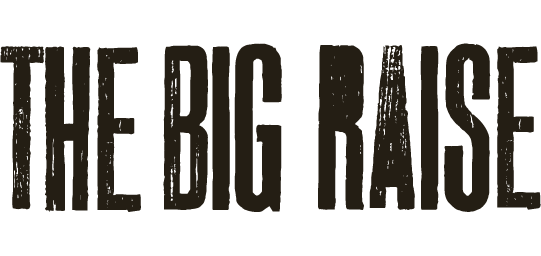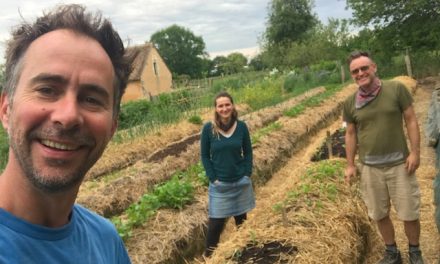One of the first things we did after buying The Big Raise was to commission a land analysis from the renowned soil scientists, Dr, Dr & Dr Bourguignon. Charles and Perrine of Bec Hellouin Permaculture Farm in Normandy told me they wished they’d done this at the start – it would have saved them eight years of hard labour in the fields!
The main headline from the soil analysis is that our six-hectare field is acidifying.
Basically, it’s been cut for hay two or three times a year, but no fertility has been put into it – no compost, no animal manure, no nothing. The only two places where the soil is any good are around the two big oak trees in the middle of the field and around the perimeter. That’s because the leaves, twigs and branches that fall from the trees naturally decompose and are converted into quality soil.

Four Oak Wood at The Big Raise
The fruit and nut trees we already have (thanks to Steve, the former owner) are all being given a dressing of comfrey (a nutrient accumulator that grows freely on our land) or well-rotted horse manure, and then a covering of straw to reduce the nutrient competition from grasses.
Dr Emmanuel Bourguignon is the son of Dr Claude and Dr Lydia Bourguignon. Claude and Lydia are in the process of retiring. Emmanuel is taking over their work. He came to visit us on a cold, sunny day in late November and we spent three hours inspecting the land together.
Several months later Emmanuel’s report arrived in our inbox. One of his key messages was that we needed to add more biomass on to the land because of the increasing acidity and the high levels of clay, which we already knew about and reported last October when we cleaned out our pond.

Dredging the pond
We spread the mud dredged from the pond around the field, which is great news for the fertility of our land because mud is organic matter (leaves, branches etc.) that’s decomposed under water. Emmanuel arrived a couple of months after the pond cleanout and was already able to see the evidence of worms doing their work on the excavated mud and pioneer plants helping by breaking it up.
We recently borrowed a (diesel-powered) truck to clean the local pony club out of manure. Being a bit of novice my first attempt to dump my load at The Big Raise led to me bury the truck’s tailgate under three tonnes of shit! I had to dig it out by hand – much to the amusement of the roofers who’d lent me their truck! (N.B. In January I went to the pony club for a second haul and, on my return, got the truck stuck in our very wet field. I had to be hauled out by my neighbour with his tractor!!!)

It’s a shitty view but at least it’s yellow!
More recently a couple of friends, Frédéric and Khalil, joined us for a weekend of shit shovelling. On day one we were struggling to find the manure under the snow! No chance of losing Khal in his orange and red jumpsuit though!!!
We’ll get more biomass from the nettles, thistles and other so-called weeds (plants in the wrong place!) that are to be found all over the farm. Any excuse to get the scythe out!

Hervé Poldark & Alexis scything the nettles in Four Oak Wood
We’re making compost out of “weeds”, manure, straw and grass cuttings using the “lasagne” technique I learnt at the Bec Hellouin Permaculture Farm.

Blanche modelling the latest in practical clothing for composting
Emmanuel also said we needed to put calcium carbonate on the land. It can be purchased in powder form, but oyster shells are basically made of calcium carbonate. So now, whenever we get our hands on oysters, the shells go on to the land (rather than into the Seine which is where we use to throw them!).

Rebelle, the neighbour’s dog, helping me to crush oyster shells
And whenever we visit Blanche’s birthplace, Brittany, we bring back a load of seaweed which is good for the soil, although apparently it leads to a temporary (15-week) reduction in nitrogen available for plants as bacteria take nitrogen from soil to break down the seaweed.

Just what the doctor ordered: a rich diet of seaweed, horse manure and oyster shells
But that’s ok as the aim is to start planting fruit trees next winter by which time, hopefully, our natural fertility treatment should have made a big difference.
















